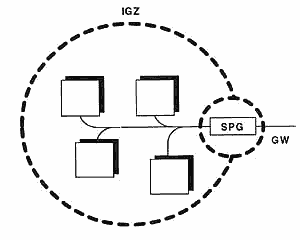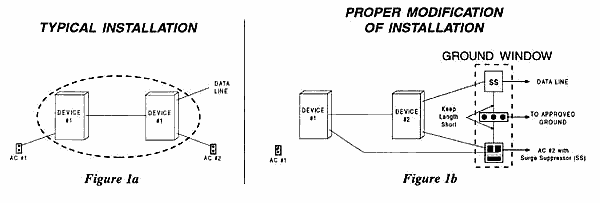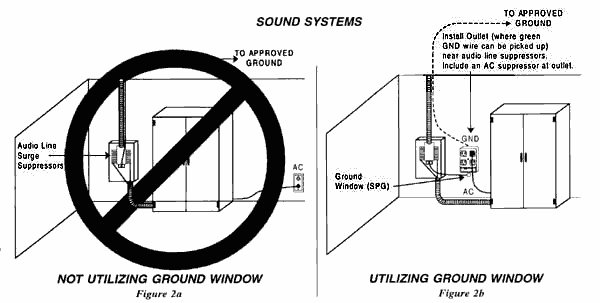EDCO SURGE PROTECTION GROUND
WINDOW CONCEPT
![]()
Definitions

1. Isolated Ground Zone (IGZ)
This is an imaginary circle drawn around and encompassing a local cluster of electronic equipment (items located in close proximity to each other).
2. Single Point Ground (SPG)
This is a common ground point, or node, used in the IGZ to bond all ground references inside the IGZ together.
3. Ground Window (GW)
The ground window is a hypothetical "small opening" in the IGZ through which all electrical conductors enter or leave. The SPG is located at the ground window.
Ground Is Not Always Ground
Surge currents passing through a ground conductor generate a voltage across the conductor. This is primarily due to inductance of the wire. Inductance is highly dependent on conductor length. It is, therefore, very important to keep suppressor ground wires to the SPG very short. Figure Ia illustrates a typical installation of equipment within a small area, such as an equipment room. There are three problems associated with the installation depicted in Figure Ia. An imaginary circle (IGZ) is included on the drawing to help illustrate the concept.

Problem #1: Multiple Grounds
In Figure Ia, there are three ground references leaving the circle. AC outlet #1, AC outlet #2, and the data line all present separate ground references at the circle intersection point. The two AC outlet grounds are connected together at the power panel. many feet away. The ground wire lengths offer enough inductance to effectively create separate grounds at the (IGZ). In addition. the data line may run hundreds of feet to yet another ground reference in remote circuitry.
Problem #2: Wiring Entering and Leaving the Circle (IGZ)
Observe in Figure la the substantial distance between various conductors leaving the circle. Even if ground conductors were bonded together in Figure Ia, destructive voltages would exist during a surge due to wire inductance.
Problem #3:
The Data Lines/AC Service Lack Surge Suppressors2. SOLVING THE PROBLEMS
The problems listed above are solved by employing the concepts described in the definition section above. Figure lb illustrates the proper modification of thc installation
· Both devices are now powered from the same AC outlet.
· The AC outlet incorporates a surge suppressor.
· The ground window is established at the AC outlet.
· Data line suppressor(s) are added at the ground window.
· An SPG bus bar is located at the ground window to facilitate multiple ground connections.
· Ground wires to the suppressors are very short.
· An optional, (depending on code), ground conductor connects the SP(; to the main building power ground. This conductor may be quite long, but that does not create a problem, now that the SPG has been established at the ground window.
3. SUMMARY RULES
In summary, the following rules need to be observed:
1. Keep all grounds inside the IGZ at the same potential. If different ground potentials are present on electronic equipment, damage will occur regardless of the suppression used.
2. Protect all electrical circuits entering or leaving the IGZ at the ground window. This keeps circuits at a safe voltage with respect to the ground window. This safe voltage is the "clamp" voltage (let-through voltage) of the respective suppressors.
PRACTICAL CONSIDERATION:
The majority of sites are fairly simple and only involve bonding suppressor grounds to AC service grounds at the ground window. Existing sites may involve some rewiring to accomplish best results. In order to keep the signal line surge suppressor ground and AC service ground very short, sometimes wiring must be moved. For systems with signal ]ines, it is often easier to move the AC service outlet over to the vicinity of the signal line surge suppressors. (Ref Fig. 2b) Three practical illustrations contrasting proper and improper installations are shown in Figures 2 through 4.


To speak to one of our consultants, please call us at 1-800-543-8790
